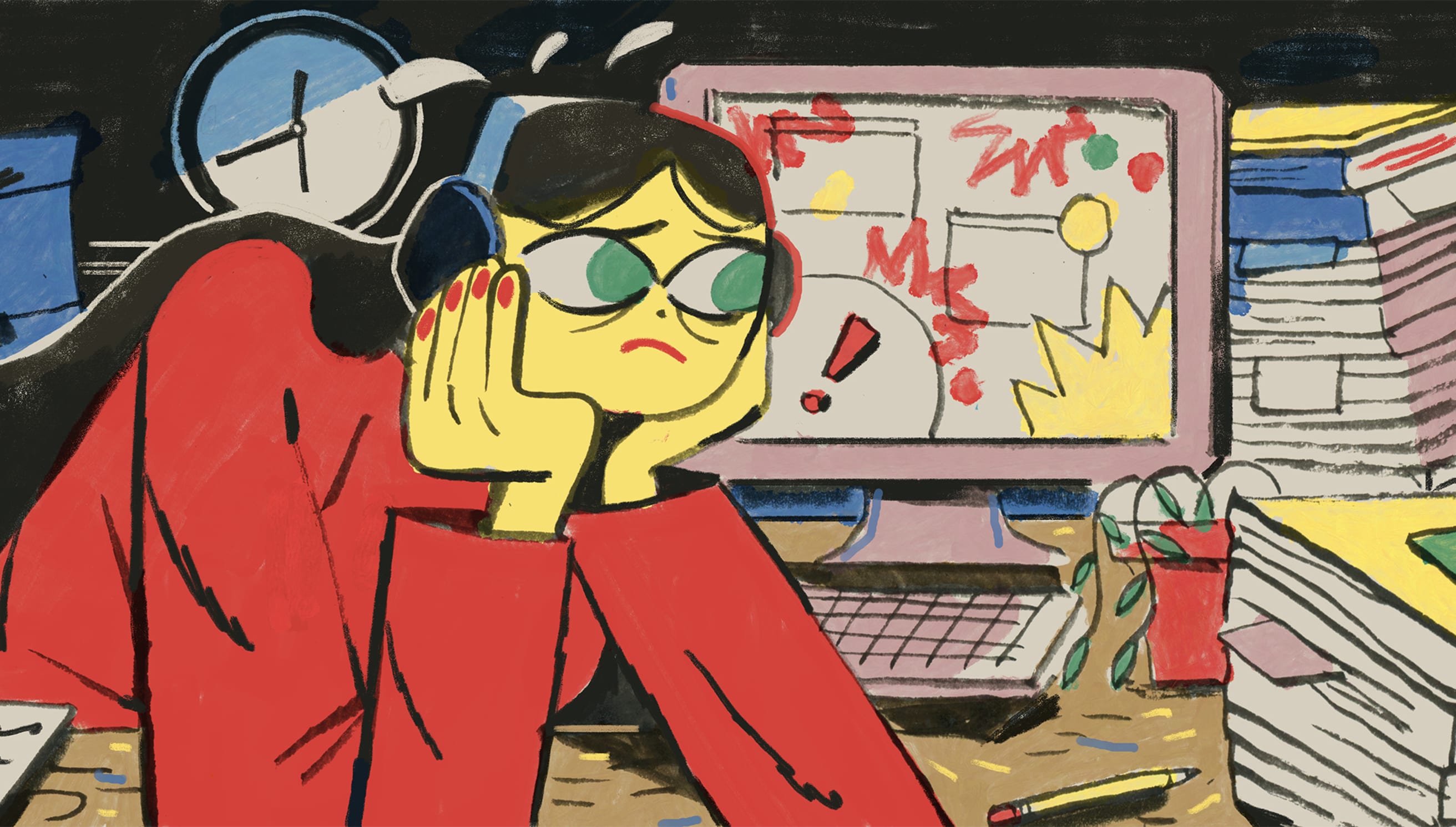Chess grandmasters burn up to 6,000 calories a day during tournaments, just by sitting there and thinking.
When I reach a point of mental exhaustion, I like to reflect on that fact. Too often, our mental energy — or lack thereof — feels like a moral deficiency rather than a physical one.
If I had more willpower, I could power through and get this done. Why can’t I just focus? What’s wrong with me?!
It’s easy to forget that our brains require energy to function. We wouldn’t run a marathon and then feel like failures when our legs are tired. So why do we treat mental fatigue so differently? Our brainpower is exhaustible, but it’s 100% renewable if we manage it wisely.
Think of this article as your marathon training program for your brain. I can’t promise you’ll never feel mental fatigue but you can experience it less often, less severely, and with fewer negative consequences for your mental health and productivity.
First things first, what do we even mean when we say “mental fatigue”?
What is mental fatigue?
Mental fatigue is the feeling that your brain just won’t function right. People often describe it as brain fog. You can’t concentrate, even simple tasks take forever, and you find yourself rereading the same paragraph or tweaking the same line of code over-and-over again. Things that would have rolled off your back in the morning become more irksome and you get impatient with coworkers.
Mental fatigue can be acute or chronic. Acute fatigue is short-lived and is relieved after a brief period of rest. Most of us experience acute fatigue during an afternoon slump or at the end of a particularly hectic day. Acute fatigue is normal.
However, if left unaddressed, acute fatigue can snowball into chronic fatigue and ultimately lead to burnout. Identify the root causes of your mental fatigue and take proactive steps to manage it early on.
What causes mental fatigue?
Mental fatigue is complex and usually isn’t caused by one thing. Contributing factors can be physical— like poor nutrition, lack of sleep, or hormonal imbalances — or cognitive — you’ve been asking your brain to do too much.
That cognitive overload can take the form of intense focus on a single task over an extended period of time — as is the case for those chess grandmasters who burn 6,000 calories in a day. But it can also result from spreading your attention across too many things — all of the decisions you have to make, the information you have to process, the emails you need to answer, the tasks you need to keep track of, the chores you need to take care of. To make matters worse, worrying about a task can be as mentally taxing as actually doing it. That means even while you're procrastinating, you’re taxing your brain.
All of that cognitive task-switching takes a toll. Imagine a chess player trying to plan out their next five moves and anticipate their opponents’ reactions while also checking their Slack messages, responding to emails, thinking about what they’ll eat for lunch, catching up on the latest trending hashtags on Twitter, and worrying about that project due tomorrow that they haven’t even started yet.
It’s common sense that each additional cognitive task will fatigue the chess player’s cognitive functioning faster. Yet, that’s exactly how most of us operate on a daily basis. Mentally juggling dozens of tasks and responsibilities has become our normal. It’s no wonder we feel mentally exhausted at the end of the day!
Luckily, there are steps you can take to manage both the physical and cognitive sides of mental fatigue.
Give your brain high-quality fuel
The link between athletic performance and nutrition is obvious, but when it comes to mental performance, we don’t always make the same connection. To be clear: Your brain is fueled with the same food as your muscles! In fact, our brains are the gas-guzzling Hummers of the body’s organs using up over half of the glucose in our bloodstream. That means what you eat impacts your cognitive functioning in a big way.
There’s a lot of confusing and conflicting science out there about proper nutrition, but you don’t have to go paleo or keto or become the Sad Salad Guy at work to avoid mental fatigue in the middle of the day. Here are some basic guidelines for maintaining sufficient energy levels throughout the day without sacrificing too much:
- Cut down on refined sugars. This is one piece of nutrition advice the research can agree on. A 2019 meta-analysis of the literature, found that, while there’s no evidence of an increase in mood or cognitive functioning from eating sugar even in the short-term, sugar consumption does decrease alertness within an hour and increases fatigue within 30 minutes. In other words, the sugar rush isn’t real, but the sugar crash is. Aim for sustained energy levels throughout the day by cutting down on the amount of refined sugar you eat.
- Make a plan for what you’ll eat in advance. If you wait until you’re hungry, you’re already low on energy and willpower and are more likely to crave a quick hit of energy in the form of yummy sugar (Kit Kat anyone?).
- Don’t skip breakfast. If you usually skip breakfast and then crash in the middle of the morning, try eating a breakfast that will sustain your energy levels until lunch. More eggs, yogurt, and oatmeal. Fewer donuts, muffins, and sugary cereals. See how your body reacts.
- Snack. Try giving your body consistent fuel with mid-morning and mid-afternoon snacks at a minimum. Keep lots of low-sugar, unprocessed snacks on hand – almonds, whole grain crackers and cheese, or my personal favorite, cottage cheese and apple with lots of salt.
- Stay hydrated. Studies show that even mild dehydration can negatively impact cognitive performance. Drink plenty of water – coffee doesn’t count.
- Figure out what makes you feel best. When it comes to nutrition advice, you should always be skeptical. Even the basic advice above won’t work for everyone. Some people swear by intermittent fasting, skip breakfast every day and feel great. If you’re experiencing big energy crashes in the middle of the day, try experimenting with the content and timing of your meals. Keep a log of your energy levels and see how your body reacts. In the end, only you can say for sure what makes you feel best.
Exercise
When you’re exhausted the last thing you want to do is get up and move, but studies show that physical activity might be just what you need. While the causal mechanisms aren’t entirely clear, exercise has been shown to boost overall energy levels and improve cognitive functioning, immediately and over the long-term.
So how can you start powering up your brain cells with exercise?
- Start small. You don’t have to train for a marathon or join a CrossFit gym to see the benefits of exercise. At least one study has shown that low-intensity exercise — the equivalent of an easy walk — actually boosted energy more than moderate-intensity exercise. Set a goal to go for a 10-minute walk every day. Once you’re doing that consistently, slowly increase the amount of time. Make it as easy as possible to get started.
- Do it at the same time every day. When you make a plan for when you’ll do something, you’re more likely to actually do it. When you do it at the same time every day, triggered by the same events — for example, waking up, taking a lunch break, or ending the workday — it’s easier to build a consistent habit.
- Get an accountabilibuddy. Everything is easier with friends.
- Do group fitness. If you can swing it, join a gym that has a set group class schedule you have to sign up for. I find that having someone else tell you exactly what to do removes a lot of the mental effort involved in exercising. All I have to do is get my lazy butt there and the rest of the decisions are made for me. During the pandemic, most gyms are providing virtual classes which makes them even more accessible.
- Find a physical activity you enjoy. Or at least hate less than other forms of exercise. If you hate running, it’s going to be hard to stick with the habit. Try power yoga, rock climbing, surviving the zombie apocalypse, or Quidditch. Make physical activity feel like playtime and you’ll never have to exercise again.
Prioritize sleep
Sleep is the most productive thing you do all day. Period. No one really knows why we need sleep. We just know bad things happen when we don’t get enough of it.
Despite its paramount importance to your health, happiness, and productivity, sleep feels optional. Your boss holds you accountable to deadlines. Your friends expect you to show up when you say you will. Your family relies on you to get dinner on the table. But no one is holding you accountable for getting enough sleep except you.
Here are some science-backed ways to improve your quality of sleep:
- Keep it cool, dark, and quiet. Ikea has relatively cheap, acceptably attractive blackout curtains. If curtains are a no-go, get yourself a sleep mask. If you live on a busy street like myself, get yourself some earplugs. Keep your room at a comfortable temperature if you can. Between 65 and 72 degrees fahrenheit (18-22 degrees celsius) is the general recommendation, but play around with the temperature to find what’s most comfortable for you.
- No screens before bed. The blue light messes with your body’s natural clock so stop looking at screens before bedtime and ban them from your room entirely. Get an old-school alarm clock with the sole function of telling time and waking you up when you tell it to.
- Have a calming bedtime routine. The Morning Routine gets all the attention, but the less glamorous Bedtime Routine is equally important. Doing the same series of relaxing habits every night before bed signals to your body and mind that it’s time to wind down for the day.
- Keep a consistent wake-up time. Your natural body clock is set to the time you wake up rather than the time you fall asleep. If you want to consistently get better sleep, it’s more important to wake up at the same time every day, even if you slept poorly or stayed out late the night before.
- Don’t drink coffee after noon. Caffeine has a half life of 4-6 hours, so if you want to fall asleep by 10pm you should switch to decaf – or better yet, water – by noon.
Build your workday around your energy levels
No matter how much you sleep, how many miles you run, or how even you keep your blood sugar levels, you’ll experience natural ebbs and flows in your energy throughout the day. Those are your ultradian rhythms.
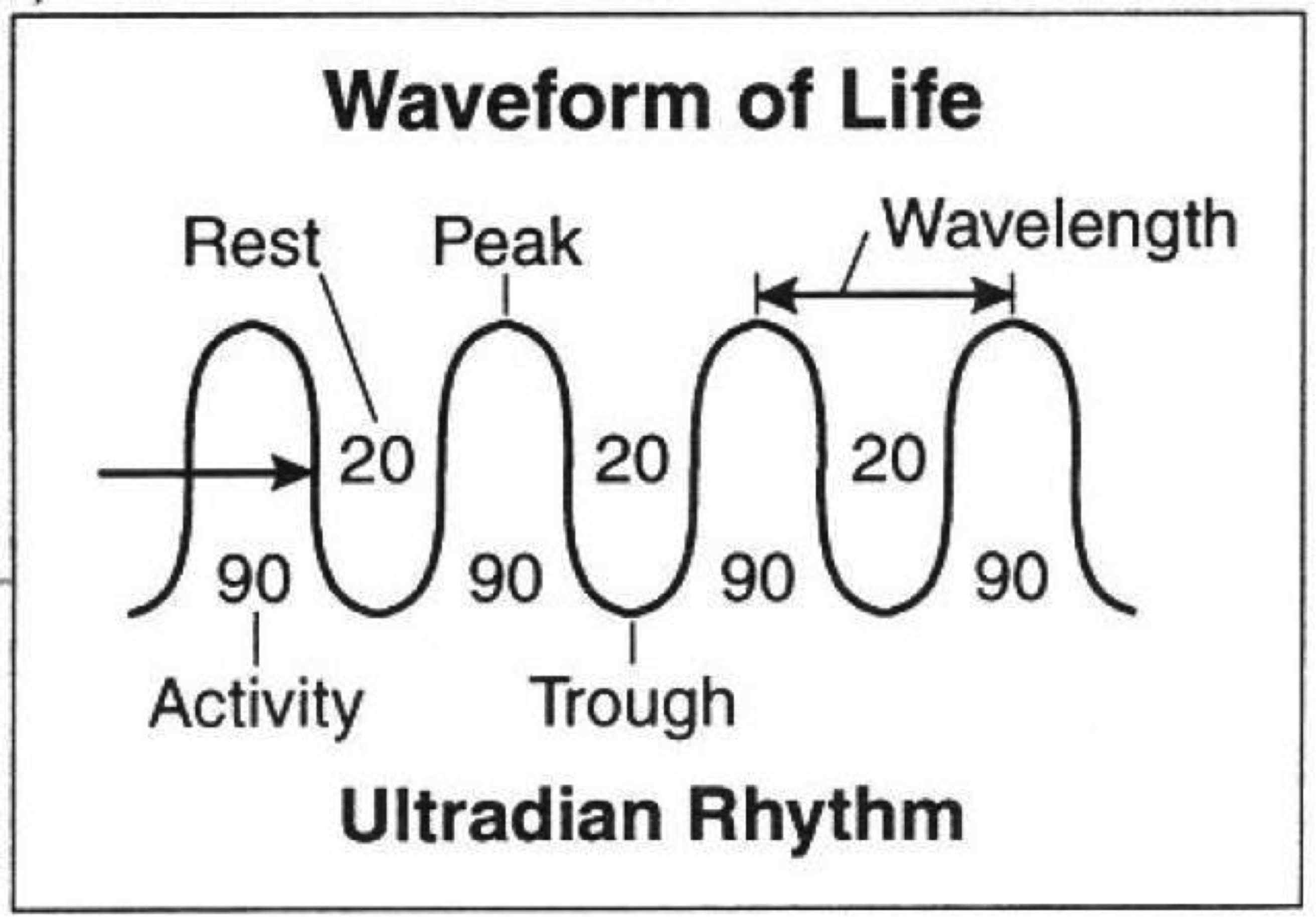
Ultaradian rhythms are driven by a whole host of things happening in your body — hormone levels, metabolic processes, cardiovascular functioning — and they affect your energy, mood, and cognitive functioning. These rhythms take the form of 90-minute peaks of energy followed by a 20-minute trough that repeats throughout the day with the peaks trending lower and lower as the day goes on.
You can’t escape the natural rhythms of your body, so plan your day to work with them. Here’s how:
- Identify your rhythms. While everyone experiences ultradian rhythms, they won’t occur at the same time for everyone. Take a week to note your energy levels throughout the day. Look for patterns for when your energy levels are highest and lowest. Here’s a weekly log courtesy of Daniel Pink you can print and keep at your desk. Set an alarm every 90 minutes and rate your mental alertness and energy levels.

When your energy levels are high do:
- Your not urgent and important tasks — the ones that always get pushed off to later because they don’t have deadlines
- Your cognitively demanding tasks that require focus — aka your “deep work”
- Any important decision-making and planning
When your energy levels are low:
- Do unimportant or smaller tasks that don’t require a lot of thinking
- Respond to emails
- Take care of personal admin things
- Read articles you’ve saved for later
- Get creative — studies show that people perform better on creative tasks when their energy levels aren’t at their peak

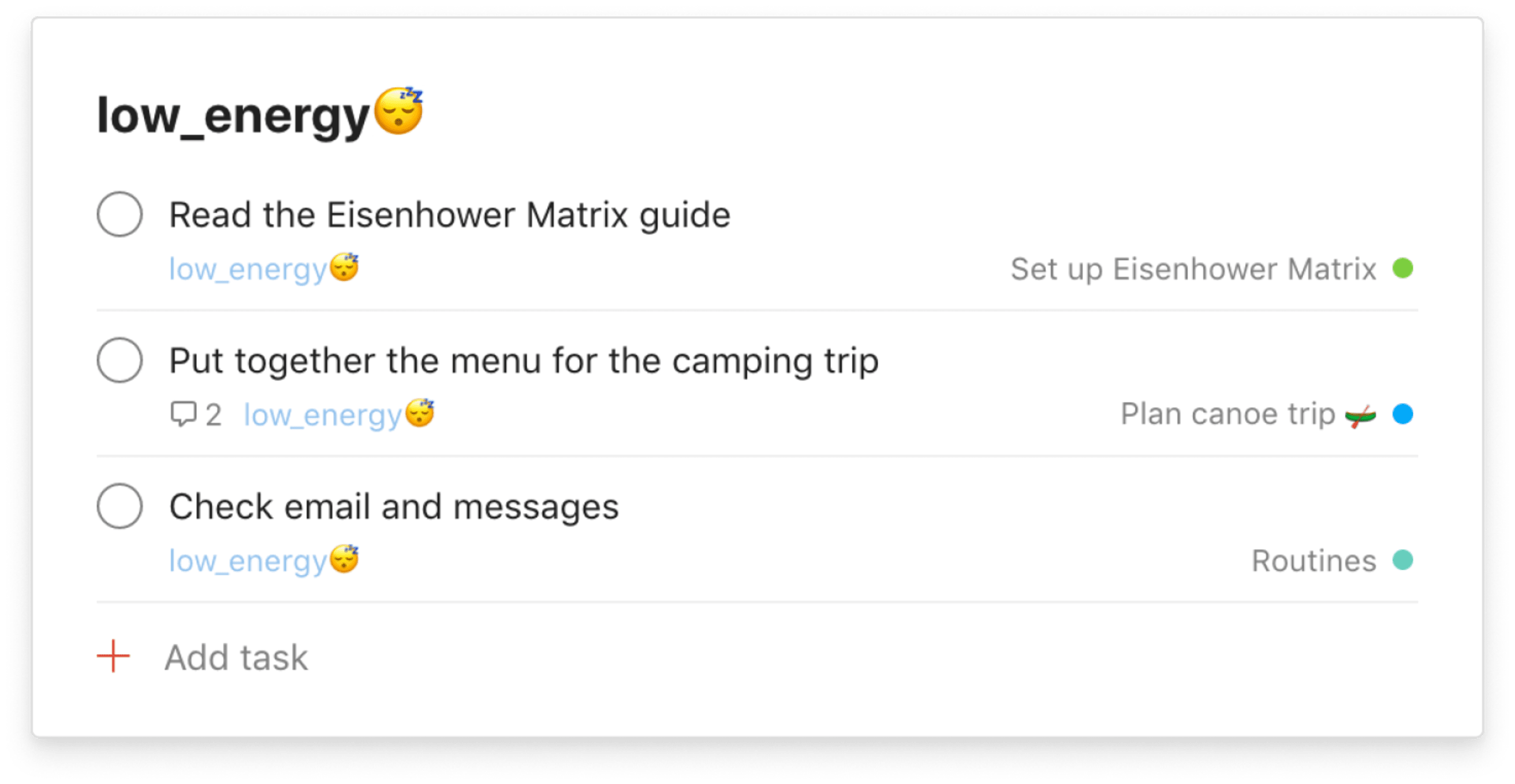
Having a hard time identifying which tasks should be “high energy” and which ones should be “low energy”? The Eisenhower Matrix is a helpful framework for distinguishing between the two.
Take strategic breaks throughout the day
Your energy levels will naturally deteriorate over the course of the day, but there’s a simple way to recharge your batteries: take breaks.
Instead of pushing to the point of mental fatigue, give your brain a chance to relax and reset. Will your energy return to peak levels? Probably not, but a regular refresh will help you sustain your focus over a longer period of time instead of crashing by midday.
In his book When: The Scientific Secrets of Perfect Timing, Daniel Pink gives this advice for taking more productive breaks:
-
Something beats nothing. High performers work for fifty-two minutes and then break for seventeen minutes.
-
Moving beats stationary. One study showed that hourly five-minute walking breaks boosted energy levels, sharpened focus, and “improved mood throughout the day and reduced feelings of fatigue in the late afternoon.”
-
Social beats solo. Research in South Korean workplaces shows that social breaks—talking with coworkers about something other than work—are more effective at reducing stress and improving mood than either cognitive breaks (answering e-mail) or nutrition breaks (getting a snack).
-
Outside beats inside. People who take short walks outdoors return with better moods and greater replenishment than people who walk indoors.
-
Fully detached beats semi-detached. Tech-free breaks also increase vigor and reduce emotional exhaustion.
Or you may want to use an afternoon break to just sleep. “Power naps” have been shown to improve alertness and mood, counteracting the afternoon slump. Just don’t sleep too long! A 20-40 minute nap at a low-energy point between noon and 4pm works best for most people.
Manage mental load at the source
Think of your brain like the RAM on your computer — that’s the short-term data storage your computer needs to do whatever you’re asking it to do right now. When you have one program open running one task, all the RAM is dedicated to that one thing and everything zips along nicely. But then you open another window. And another. And then a new internet tab or twenty. Each additional demand on your computer slows things down.
You have two choices: you can either increase your “RAM” (see the above points on nutrition, sleep, exercise) or you can decrease the number of applications you have open at any given time. Here are some of the ways you can lighten your mental load:
- Only touch things once. I have an email sitting in my inbox that’s 3 months old. It’s not that important, but it does require a response. I see it every time I check my email. I’ve opened it multiple times. I haven’t actually done anything about it, yet it continues to take up little bits of precious mental energy. Don’t do that. Instead follow the “touch it once” rule:
“The general idea is that as soon as you touch something, whether it’s a piece of mail or a project that needs to be filed, you immediately act on it. This could be fully completing the task at once or determining the next actionable steps to move it along.”
- Time block your emails. Answering email is exhausting to begin with, but bouncing back and forth between your inbox and whatever other tasks you need to get done is even worse. Instead, set aside 2-3 specific “time blocks” throughout the day to process your inbox. Check and answer emails during those times and only those times. That goes for checking team messaging apps like Slack or Twist too.

- Focus on one thing at a time. Only have one application open on your computer, figuratively speaking.
- Identify which decisions you can put on autopilot. For example, wear the same outfit every day, eat the same breakfast, keep the same exercise routine. Variety is the spice of life, but too much decision-making will wear out your brain.
- Learn how to say no. Each additional responsibility you take on increases the mental load on your brain. Take a good, hard look at your commitments vs your mental capacity and cull everything that isn’t essential.
[cta_todoist][/cta_todoist]
Disconnect at the end of the workday
I don’t just mean physically disconnecting. If you shut your laptop, but your brain is still working overtime worrying about your to-do list it doesn’t count as disconnecting. Your brain needs time to rest and recover every day, but that’s easier said than done. It’s especially hard when your office is also your home as is the case for so many of us right now.
That’s why Cal Newport, computer science professor and author of Deep Work, thinks that everyone should have a work shutdown ritual — a consistent series of tasks that signals to your brain that it can stop thinking about work for the day.
- Update and organize your to-do list. Your brain tends to worry over unfinished tasks, but you can temporarily trick it into thinking you’ve finished the task by making a plan to finish it. That’s why writing out a to-do list can provide mental relief even when you still have the exact same amount of work left. Doist’s founder and CEO, Amir, makes it a habit to get to “to-do list zero” at the end of every day by rescheduling any leftover tasks for later in the week.
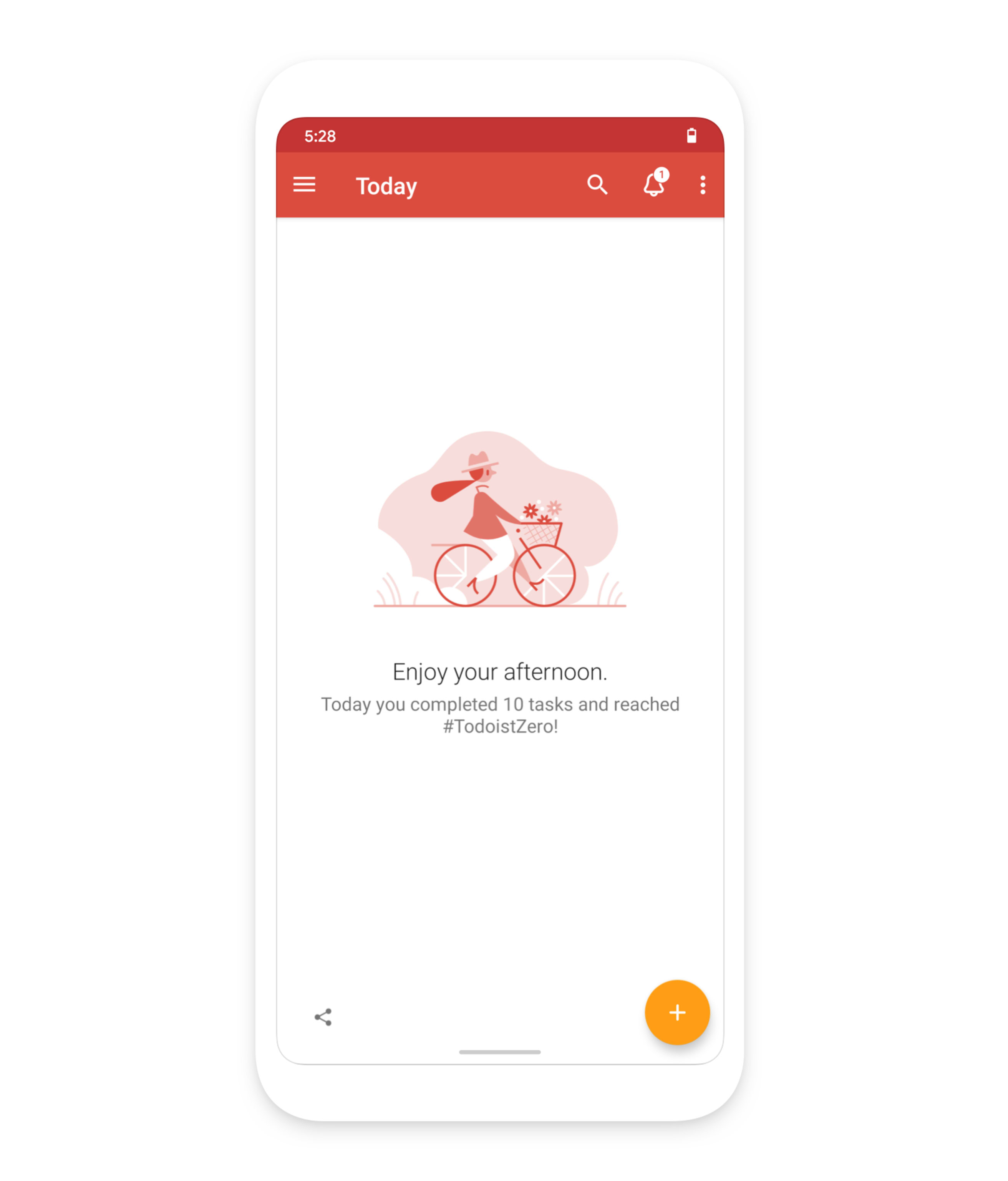
- Schedule a commitment at the end of the workday. It’s hard to pull yourself out of work mode even when you know you should so schedule something you can’t miss for the end of the day – like dinner (or a Zoom call) with friends or that group fitness class we talked about earlier.
- Turn off all notifications from work apps on your phone. If you can, delete work apps on your phone entirely. They’re just too tempting and habit-forming. A “quick peek” during dinner can pull your mind right back into work mode.
And don’t forget to take longer, disconnected vacations every once in a while.
If you really have to push through…
The best way to deal with mental fatigue is to take proactive steps to minimize it in the first place and then work around it as best you can. But sometimes you just have to slog through your energy troughs.
If you’re working up against a deadline — like, I don’t know, say finishing an article about mental fatigue before you leave for vacation just to give a random example — and you absolutely have to get something done, try breaking the task down into the next tiny step that will take 10 minutes or less to complete. In our totally hypothetical example, that might be “finish writing this paragraph”. Set a timer and get to it. Once the timer goes off, identify the next micro-task and work on that.
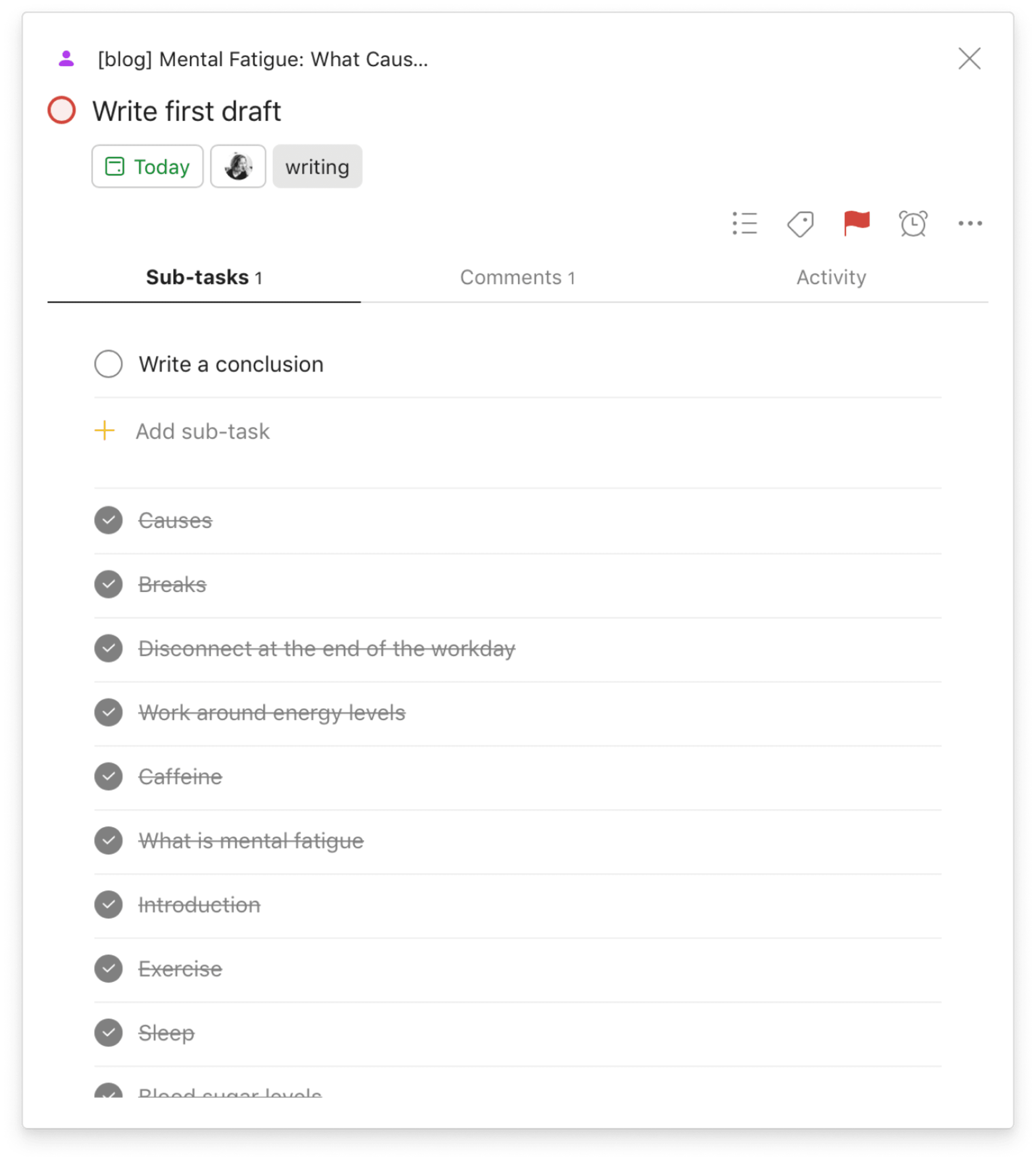
If you have to force your way through a mental slump, break work down into micro-tasks you can finish in 10 minutes or less.
Maybe you’ll get through the energy trough and out to the other side, or maybe it’ll continue to be a slog. Either way, you’ll be making progress instead of getting stuck in a foggy, unproductive loop.
It’s hard to see your way out of mental fatigue while you’re experiencing it. Acknowledging that fatigue is a natural result of challenging your brain can be freeing in and of itself. Yes, there are things we can do to boost our energy levels, but in the end we’re not Energizer bunnies. We need to learn to work with our natural rhythms instead of simply trying to overcome them.
Next time, instead of rereading the same paragraph for the fifth time or rewriting that line of code for the tenth, give yourself permission to step away, rest your brain, and tackle the problem when you’re fresh.
